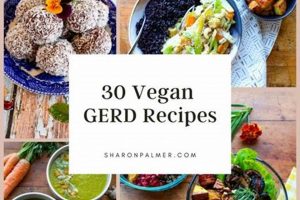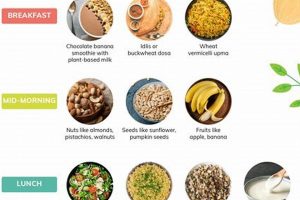Gastrointestinal discomfort, characterized by a feeling of fullness, tightness, or swelling in the abdomen, can arise when individuals transition to plant-based eating patterns. This sensation is often accompanied by visible distention of the abdomen. For example, an individual might experience increased abdominal pressure and a noticeably larger waist circumference after consuming a meal rich in legumes and cruciferous vegetables.
Understanding the factors contributing to this phenomenon is important for optimizing digestive well-being and ensuring adherence to a vegan lifestyle. Addressing this issue allows individuals to enjoy the ethical and potential health advantages associated with plant-based diets without experiencing unwanted physical discomfort. Historically, traditional diets have often incorporated practices to mitigate these effects, such as soaking legumes or employing specific cooking methods to reduce gas production.
The following sections will examine common dietary components and physiological mechanisms that may contribute to the occurrence of this digestive challenge when following a plant-based nutritional approach, along with strategies for alleviation and prevention.
Mitigating Gastrointestinal Discomfort with Plant-Based Diets
Adopting a vegan diet can sometimes lead to increased abdominal distension and discomfort. The following evidence-based strategies aim to reduce these effects.
Tip 1: Gradual Dietary Transition: Implement changes to the diet gradually. A sudden increase in fiber intake can overwhelm the digestive system. Slowly increase the consumption of high-fiber foods such as beans, lentils, fruits, and vegetables over several weeks to allow the gut microbiota to adapt.
Tip 2: Thorough Food Preparation: Employ proper food preparation techniques. Soaking legumes overnight and discarding the soaking water can significantly reduce the levels of oligosaccharides, which are known to contribute to gas production. Thoroughly cooking cruciferous vegetables, such as broccoli and cabbage, can also aid digestion.
Tip 3: Strategic Food Combinations: Consider food combinations. Some individuals experience discomfort when consuming certain foods together. Experiment with separating high-fiber foods from high-fat foods or starchy foods to identify potential triggers.
Tip 4: Adequate Hydration: Ensure sufficient fluid intake. Fiber absorbs water, so adequate hydration is crucial for preventing constipation and facilitating smooth digestion. Drink plenty of water throughout the day, especially when increasing fiber consumption.
Tip 5: Mindful Eating Practices: Practice mindful eating. Eating slowly, chewing food thoroughly, and avoiding distractions can improve digestion and reduce the likelihood of swallowing excess air, which can contribute to abdominal distension.
Tip 6: Probiotic Supplementation: Consider probiotic supplementation. Introducing beneficial bacteria to the gut can aid in the digestion of plant-based foods and reduce gas production. Consult with a healthcare professional to determine the appropriate probiotic strain and dosage.
Tip 7: Identify Trigger Foods: Maintain a food journal. Track food intake and associated symptoms to identify specific foods that consistently trigger gastrointestinal discomfort. Common culprits include high-FODMAP foods such as onions, garlic, and certain fruits.
By implementing these strategies, individuals may reduce discomfort and improve their ability to adhere to a vegan dietary pattern. These adjustments can optimize the digestive process and enhance overall well-being.
The subsequent section will delve into more advanced management techniques and situations where professional medical advice is warranted.
1. Fiber Quantity
Dietary fiber, a significant component of plant-based diets, exerts a profound influence on gastrointestinal function. The quantity of fiber consumed directly impacts digestive processes, potentially contributing to abdominal distension.
- Increased Intestinal Fermentation
A higher fiber intake provides increased substrate for bacterial fermentation in the colon. This fermentation process yields gases such as hydrogen, methane, and carbon dioxide. The accumulation of these gases leads to increased abdominal pressure and a sensation of bloating.
- Water Retention
Certain types of fiber, particularly soluble fiber, absorb water in the digestive tract. While this can aid in stool formation, excessive water absorption can also contribute to a feeling of fullness and abdominal swelling. The increased volume of intestinal contents may exacerbate subjective feelings of distension.
- Slower Gastric Emptying
Fiber slows down the rate at which food empties from the stomach into the small intestine. This delayed gastric emptying can lead to prolonged feelings of fullness and upper abdominal discomfort. The extended residence time of food in the stomach may contribute to increased gas production and bloating.
- Adaptation Period
The digestive system requires time to adapt to increased fiber intake. A sudden increase in fiber consumption can overwhelm the gut microbiota, leading to increased gas production and abdominal discomfort. Gradual increases in fiber intake allow the gut microbiota to adjust and efficiently process the fiber, potentially reducing the likelihood of gastrointestinal symptoms.
The interplay between these facets underscores the complexity of the relationship between fiber quantity and abdominal distension. While fiber is beneficial for overall health, careful management of intake and consideration of individual tolerance levels are necessary to mitigate potential digestive discomfort. Individuals transitioning to or maintaining a high-fiber, plant-based diet should implement strategies to gradually increase fiber consumption and support optimal digestive function.
2. Gut Microbiota
The gut microbiota, a complex community of microorganisms residing in the digestive tract, exerts a significant influence on the manifestation of gastrointestinal symptoms associated with plant-based diets. A diet rich in fiber, typical of vegan eating patterns, provides an abundant substrate for microbial fermentation. This fermentation process, while generally beneficial, can lead to increased gas production, contributing to abdominal distension. The specific composition of the gut microbiota determines the efficiency and byproducts of this fermentation, impacting the severity of reported symptoms. For instance, individuals with a higher proportion of gas-producing bacteria, such as certain strains of Clostridium, may experience more pronounced abdominal discomfort. Conversely, a more balanced and diverse microbiota, rich in butyrate-producing bacteria, may mitigate these effects by promoting gut health and reducing inflammation.
The adaptation of the gut microbiota to a vegan diet is a dynamic process. Initially, the sudden increase in fiber intake can lead to an overgrowth of gas-producing bacteria, resulting in transient abdominal distension. Over time, however, the microbiota can adapt, with an increase in fiber-degrading bacteria capable of efficiently fermenting plant-based polysaccharides. This adaptation can lead to a reduction in gas production and improved tolerance to high-fiber diets. The use of probiotics containing specific bacterial strains, such as Bifidobacterium and Lactobacillus, may facilitate this adaptation process and alleviate bloating symptoms. Furthermore, dietary interventions that promote the growth of beneficial bacteria, such as the consumption of prebiotic-rich foods, can contribute to a more balanced and resilient gut microbiota, reducing the likelihood of discomfort.
In summary, the gut microbiota plays a crucial role in mediating the digestive response to vegan diets. The composition and activity of this microbial community influence the extent of gas production and the overall manifestation of bloating. While initial dietary changes may lead to transient symptoms, the gut microbiota can adapt over time, potentially reducing discomfort. Understanding the intricate relationship between the gut microbiota and plant-based diets is essential for developing targeted strategies to mitigate gastrointestinal symptoms and promote optimal digestive health.
3. FODMAP Content
The presence of Fermentable Oligosaccharides, Disaccharides, Monosaccharides, and Polyols (FODMAPs) in plant-based foods warrants careful consideration when assessing gastrointestinal comfort within a vegan dietary framework. These short-chain carbohydrates are poorly absorbed in the small intestine, leading to fermentation in the colon. This fermentation process can generate gas, contributing to abdominal distension and discomfort.
- Oligosaccharides (Fructans and Galactans)
Fructans and galactans, found in foods like wheat, onions, garlic, legumes (beans, lentils), and certain vegetables, are poorly digested by humans due to the lack of necessary enzymes. Upon reaching the colon, these oligosaccharides are readily fermented by bacteria, producing substantial amounts of gas. For example, consuming a large serving of bean chili, a staple in many vegan diets, can lead to significant gas production and bloating due to the high galactan content. Similarly, the widespread use of garlic and onions in vegan cuisine can inadvertently contribute to gastrointestinal distress for sensitive individuals.
- Disaccharides (Lactose)
Although lactose is primarily associated with dairy products, individuals transitioning to a vegan diet may still experience lactose intolerance if they previously relied heavily on dairy and have reduced lactase enzyme production. While lactose itself is not typically a concern in a well-planned vegan diet, the potential for residual lactose intolerance stemming from prior dietary habits should not be overlooked. Accidental consumption of products containing dairy derivatives, though unintended in a vegan context, can still trigger symptoms.
- Monosaccharides (Fructose)
Excess fructose, particularly when present in a higher concentration than glucose, can be malabsorbed. High-fructose fruits like apples, pears, mangoes, and honey (though not vegan) can contribute to digestive issues in susceptible individuals. Agave nectar, sometimes used as a vegan sweetener, is also high in fructose and should be consumed in moderation. The malabsorbed fructose draws water into the small intestine, leading to increased intestinal motility and potentially contributing to diarrhea and bloating. For example, consuming a large green smoothie with several servings of high-fructose fruits can exacerbate these symptoms.
- Polyols (Sugar Alcohols)
Polyols, such as sorbitol, mannitol, xylitol, and erythritol, are often used as sugar substitutes in processed foods and can also be found naturally in some fruits and vegetables. These sugar alcohols are poorly absorbed and can exert an osmotic effect, drawing water into the intestines. Their fermentation in the colon also contributes to gas production. Vegan products marketed as “sugar-free” may contain significant amounts of polyols, potentially leading to bloating and abdominal discomfort. For instance, sugar-free vegan desserts or chewing gum containing xylitol can trigger these effects.
Understanding the FODMAP content of common vegan foods is essential for managing gastrointestinal symptoms. Employing strategies such as reducing the consumption of high-FODMAP foods, using low-FODMAP alternatives, and employing appropriate cooking methods (e.g., soaking legumes) can mitigate these effects. Consulting with a registered dietitian experienced in plant-based diets can provide personalized guidance on managing FODMAP intake and optimizing digestive well-being within a vegan lifestyle.
4. Enzyme Production
The human digestive system relies on a diverse array of enzymes to break down complex food molecules into smaller, absorbable units. When transitioning to a vegan diet, the composition of macronutrients shifts, often increasing fiber and complex carbohydrates. If the body’s enzyme production is insufficient or not optimally adapted to these changes, incomplete digestion can occur. Undigested carbohydrates then reach the colon, where they are fermented by bacteria. This bacterial fermentation produces gases, such as hydrogen, methane, and carbon dioxide, leading to abdominal distension. A specific example includes individuals with limited amylase production struggling to digest large quantities of starches from grains and potatoes, common staples in many vegan diets. This undigested starch ferments in the colon, contributing to reported bloating.
The body’s enzymatic response to dietary changes is not instantaneous. It takes time for enzyme production to upregulate in response to new dietary patterns. Furthermore, certain plant-based foods contain enzyme inhibitors that can interfere with digestion. For instance, raw legumes contain trypsin inhibitors, which can hinder protein digestion if the legumes are not properly cooked. Similarly, phytic acid, present in grains and legumes, can bind to minerals and inhibit the activity of certain digestive enzymes. Proper food preparation techniques, such as soaking, sprouting, and cooking, can reduce the levels of enzyme inhibitors and improve nutrient bioavailability, thereby easing the digestive burden. Understanding the effects of enzyme inhibitors and employing appropriate preparation methods is crucial for minimizing digestive distress.
In summary, a critical link exists between enzyme production and the occurrence of abdominal distension when adopting a vegan diet. Inadequate enzyme production, the presence of enzyme inhibitors, and a slow adaptive response of the digestive system can all contribute to incomplete digestion and subsequent gas production in the colon. Employing strategies to optimize enzyme function, such as gradual dietary transitions and proper food preparation, can alleviate these issues. It’s also important to seek medical advice from qualified healthcare professional if the problem persists for too long.
5. Preparation Methods
Preparation methods exert a significant influence on the digestibility of plant-based foods, thereby impacting the occurrence and severity of abdominal distension. Improperly prepared foods can contain compounds that inhibit digestive enzymes or remain difficult to break down, leading to fermentation in the colon and subsequent gas production. For example, consuming raw or undercooked legumes, which are staples in many vegan diets, can introduce trypsin inhibitors into the digestive system. These inhibitors interfere with protein digestion, causing undigested protein to reach the colon, where it is fermented by bacteria. This fermentation process results in the release of gases, contributing to abdominal bloating and discomfort. Proper soaking and cooking of legumes denatures these inhibitors, rendering the protein more digestible and reducing the likelihood of gas production.
Furthermore, specific preparation techniques can reduce the FODMAP content of certain plant-based foods. Soaking vegetables known for high FODMAP content in water helps reduce their quantity, which can alleviate their potential digestive issues, even when cooked. In addition, fermentation can be helpful in some cases. Fermenting vegetables or legumes can help break down some complex carbohydrates that are prone to cause bloating, and thus making them more digestible. The practical application of these preparation methods lies in minimizing the burden on the digestive system. Individuals transitioning to or maintaining a vegan diet can significantly reduce the incidence of abdominal distension by adopting proper food preparation practices. This includes soaking legumes, thoroughly cooking cruciferous vegetables, sprouting grains, and fermenting select foods to enhance digestibility. It allows individuals following plant-based diets to minimize these negative effects by following guidelines that focus on optimal preparation techniques that reduce the indigestible substances in their food.
In summary, preparation methods constitute a critical factor in mitigating digestive discomfort associated with vegan diets. The impact of these methods is twofold: they reduce the presence of anti-nutritional factors and enhance the digestibility of complex carbohydrates. By incorporating appropriate preparation techniques, individuals can optimize the digestion and absorption of nutrients from plant-based foods, minimizing the likelihood of bacterial fermentation and associated abdominal distension. Thus, preparation methods are more than just a step in cooking; they are fundamental aspects of maintaining gastrointestinal well-being within a vegan lifestyle.
Frequently Asked Questions
The following questions address common concerns and misconceptions regarding gastrointestinal discomfort, specifically abdominal distension, experienced by individuals adhering to a vegan dietary pattern. These answers aim to provide clarity and actionable information.
Question 1: Why does abdominal distension occur when transitioning to a vegan diet?
The increased intake of fiber and complex carbohydrates, characteristic of vegan diets, provides substantial substrate for bacterial fermentation in the colon. This fermentation process produces gases, such as hydrogen, methane, and carbon dioxide, which can lead to a sensation of bloating.
Question 2: Are certain vegan foods more likely to induce abdominal distension?
Yes. Foods high in FODMAPs (Fermentable Oligosaccharides, Disaccharides, Monosaccharides, and Polyols), such as legumes, onions, garlic, and certain fruits, are known to contribute to gas production and abdominal discomfort. These compounds are poorly absorbed in the small intestine and are readily fermented by bacteria in the colon.
Question 3: How can the effects of FODMAPs be minimized?
Strategies for minimizing the effects of FODMAPs include reducing the consumption of high-FODMAP foods, employing low-FODMAP alternatives, and utilizing appropriate cooking methods, such as soaking legumes prior to cooking. It may be helpful to seek guidance from a registered dietitian.
Question 4: Does the gut microbiota play a role in this process?
The composition and activity of the gut microbiota significantly influence the extent of gas production and the overall manifestation of bloating. A balanced and diverse gut microbiota can mitigate these effects, while an overgrowth of gas-producing bacteria can exacerbate symptoms.
Question 5: Can enzyme supplements alleviate bloating associated with a vegan diet?
Enzyme supplements containing enzymes such as amylase, cellulase, and protease may assist in the breakdown of complex carbohydrates and proteins, potentially reducing the amount of undigested material reaching the colon. However, the efficacy of enzyme supplements varies, and consultation with a healthcare professional is recommended.
Question 6: When should medical advice be sought for abdominal distension on a vegan diet?
Medical advice should be sought if abdominal distension is persistent, severe, or accompanied by other symptoms such as abdominal pain, nausea, vomiting, or changes in bowel habits. These symptoms may indicate an underlying medical condition that requires evaluation.
Managing abdominal distension associated with a vegan diet often involves a combination of dietary adjustments, lifestyle modifications, and, in some cases, medical intervention. Individualized strategies are necessary to address the unique factors contributing to these symptoms.
The following section will explore advanced dietary strategies and potential underlying medical conditions that may contribute to persistent gastrointestinal discomfort.
Conclusion
This exploration of the issue has illuminated key factors contributing to its occurrence. Dietary composition, specifically fiber and FODMAP content, alongside the pivotal role of the gut microbiota and the influence of food preparation methods, significantly impact digestive comfort. Understanding these elements is paramount for individuals adopting or maintaining plant-based nutritional patterns.
Persistent or severe abdominal distension necessitates professional medical consultation to rule out underlying gastrointestinal disorders. While dietary modifications and lifestyle adjustments can often mitigate symptoms, a comprehensive evaluation ensures optimal health outcomes. Further research into personalized dietary strategies and the modulation of the gut microbiota holds promise for enhancing digestive well-being in vegan populations.







